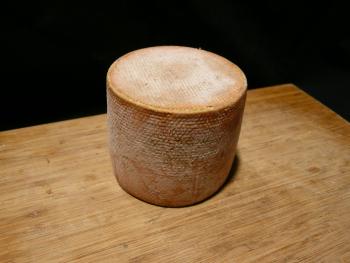Tête de Moine
- Producer
- Bellelay Abbey
- Country
- Switzerland
- Region
- Swiss Jura
- Size
- 4 ins high, 3 ins diameter
- Weight
- 2 lbs
- Website
- www.tetedemoine.ch
- Milk
- Cow
- Classification
- Firm
- Rennet
- Animal
- Rind
- Washed

Originally created by the monks of Bellelay Abbey in the Bernese Jura mountains, the recipe for Tête de Moine was passed on to local farmers whose descendents still produce the cheese today. Production has spread to many small dairies throughout the area of the Bernese Jura.
Traditionally Tête de Moine was only made from summer milk and sold from when the first leaves of autumn began to fall until March. Today it is made and sold throughout the year.
Originally called Bellelay, after the abbey, the cheese was renamed Tête de Moine after the French Revolution. Tête de Moine means "monks head" and some say the name derives from the tax levied by the abbey, whereby the farmers would provide one cheese for each monk during the season. Others believe it refers to the tonsured appearance of the cheese when it is served in the traditional way - with the top sliced off and the rind cut away to a depth of 1 inch all round.
Tête de Moine is produced in nine village dairies, using modern procedures but traditional methods for cheese production.
Cow's milk for production is delivered to the dairy twice a day and fodder for the milk cows has to come from the geographical AOC region. Silage may not be used at any time of the year, due to its negative impact on the cheese quality.
During spring, summer and autumn, the dairy cows graze in the meadows. In winter they are primarily fed on hay. Since the milk produced should be as natural as possible, the use of animal meal and hormones, genetically modified organisms, or products of any kind are strictly prohibited.
After production, cheeses from the previous day are immersed in a brine bath for at least 12 hours. By absorbing salt, the cheeses expel more water, the rind starts forming and the maturing period begins.
The cheese is shaped like a short cylinder. Young cheeses which, according to AOC rules have to be matured at a temperature of about 13-14°C within a specified region are placed onto pine boards to mature for at least 75 days in a humid cheese cellar (about 90% humidity). During that time they have to be cared for and turned regularly.
The cheeses are brushed with a mixture of a brine and bacteria culture so that they form a washed rind, a process that promotes maturing from the exterior to the interior of the cheese. No colors or chemical surface treating agents are allowed.
Tête de Moine has a firm, straw-yellow paste and a spicy, fruity flavor and aroma.
Tête de Moine is often shaved using a special cutter called a girolle. Shaving the cheeses releases all the aroma and flavors. Sometimes it is eaten with pepper and powdered cumin. Of course, the cheese can be enjoyed when sliced thinly on the cheese board and can also be shaved over salads and other dishes as a garnish.



